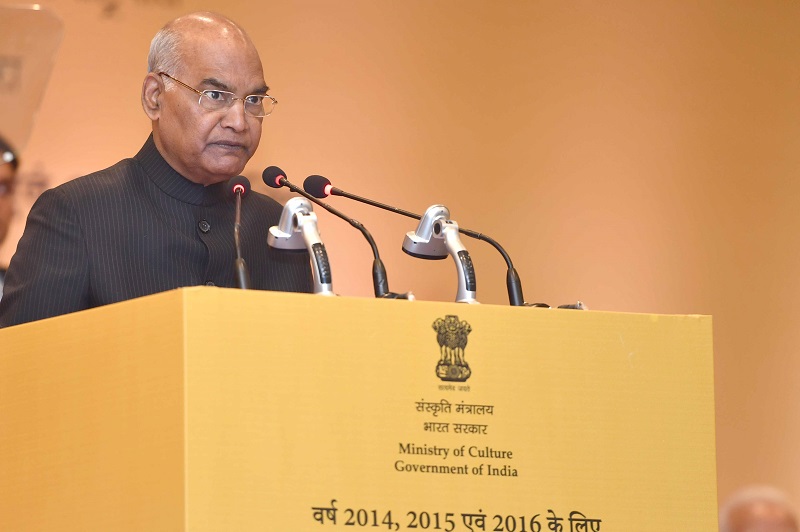ADDRESS BY THE PRESIDENT OF INDIA, SHRI RAM NATH KOVIND ON THE OCCASION OF PRESENTATION OF TAGORE AWARDS FOR CULTURAL HARMONY FOR THE YEARS 2014, 2015 AND 2016
New Delhi : 18.02.2019

1. I am happy to be here to give away the Tagore Award for Cultural Harmony for the years 2014, 2015 and 2016. I offer my congratulations to the Award winners. This Award is a celebration of Indian traditions of culture and of our civilisational wealth – whether in literature or music, art or drama, sculpture or handicrafts, design or digital art, and so many other modes of creative expression. Each region in our country has a distinct cultural identity. Yet, in its essence, culture does not divide – it unites and harmonises all of India and all of humanity.
2. This Award was instituted seven years ago in recognition of Gurudev Rabindranath Tagore’s contribution and understanding of the role of culture in enriching the human spirit – and in commemoration of his 150th birth anniversary. Gurudev was a remarkable genius. He was a writer of renown. When he won the Nobel Prize for Literature in 1913, he became the first Asian Nobel laureate. However, he was more than just a writer – he was a musician, artist, educationist and spiritual scholar of rare sensitivity. He is remembered every day as the poet who gave India its national anthem. And he remains one of our foremost cultural icons.
3. When I say "our”, I don’t mean just India – for Gurudev belongs to the world. He was a nationalist and an internationalist, a child of Ma Bharati and an advocate of Vishvabharati. That is why it is appropriate that this Award is open to all – irrespective of nationality and religion, language and ethnicity. It is open to all individuals and institutions that have made outstanding contributions to cultural harmony on our shared planet.
Ladies and Gentlemen
4. Going through the profiles of the three Award winners of this morning, I am struck by the body of their work and their efforts to use culture to further the integration of human society. I am also struck by the coincidence of their work and that of Rabindranath Tagore.
5. The Award winner for 2014, Rajkumar Singhajit Singh, is one of our greatest exponents of Manipuri dance. He has bridged this age-old art form of Manipur with not only modern sensibilities but with other parts of the country. Over 50 years ago, he stunned the world of culture by presenting Manipuri in ballet form, with the production of the dance drama "Babhruvahan”, named after the legendary king of Manipur. It is worth noting that one of Tagore’s most famous creations was the dance drama "Chitrangada” – based on the warrior-princess of Manipur, the wife of Arjuna in the Mahabharata and the mother of Babhruvahan.
6. The Award winner for 2015 is Chhayanaut, an organisation that has promoted and preserved the works and philosophy of Rabindranath Tagore in Bangladesh. The common cultures of Bangladesh and India, in West Bengal and beyond, forge a bond across boundaries. Just as Tagore’s poetry inspires Indians, it inspires the people of Bangladesh. He is the author of the national anthems of both our countries.
7. The cooperation between India and Bangladesh in recent years, in connectivity and developmental projects and, of course, in people-to-people engagement is blessed by the ethos of Gurudev. Commerce and diplomacy are travelling hand in hand with culture. This is true for Bangladesh and India; and I would say this sets an example for our entire subcontinent.
8. The final Award winner today is Ram Vanji Sutar, a sculptor and scholar who represents an art tradition that goes back thousands of years to our ancient past. These days he is most well-known for the Statue of Unity, the world’s tallest statue. This is a tribute to Sardar Vallabhbhai Patel, who played such a critical role in unifying our young nation just after Independence. About two months ago, I visited the Statue of Unity, overlooking the Sardar Sarovar Dam in Gujarat, and was left very impressed. I must compliment our Prime Minister, Shri Narendra Modi, for conceptualising and completing the Statue of Unity project.
9. An earlier encounter with Sutarji’s work was when I was a Member of Parliament and used to pass by and appreciate his statue of Mahatma Gandhi outside Parliament. That statue, capturing Gandhiji in a meditative pose, has become a signature representation of not just the Father of the Nation but also of Gandhian philosophy. It is a happy coincidence that we are celebrating the 150th birth anniversary of Gandhiji this year – and we also recall that it was Gurudev Rabindranath Tagore who was the first to call him "Mahatma” or Great Soul.
10. As such, Ladies and Gentlemen, all three of our Award winners today are not just emblems of the plural and singular beauty of India’s culture and cultural harmony, but are also linked to the life and brilliance of Rabindranath Tagore. I am confident that the beauty of cultural harmony and the brilliance of Tagore will continue to help define our national life, and our engagement with the world. With those words, I once again congratulate the Award winners and wish them the very best for future endeavours.